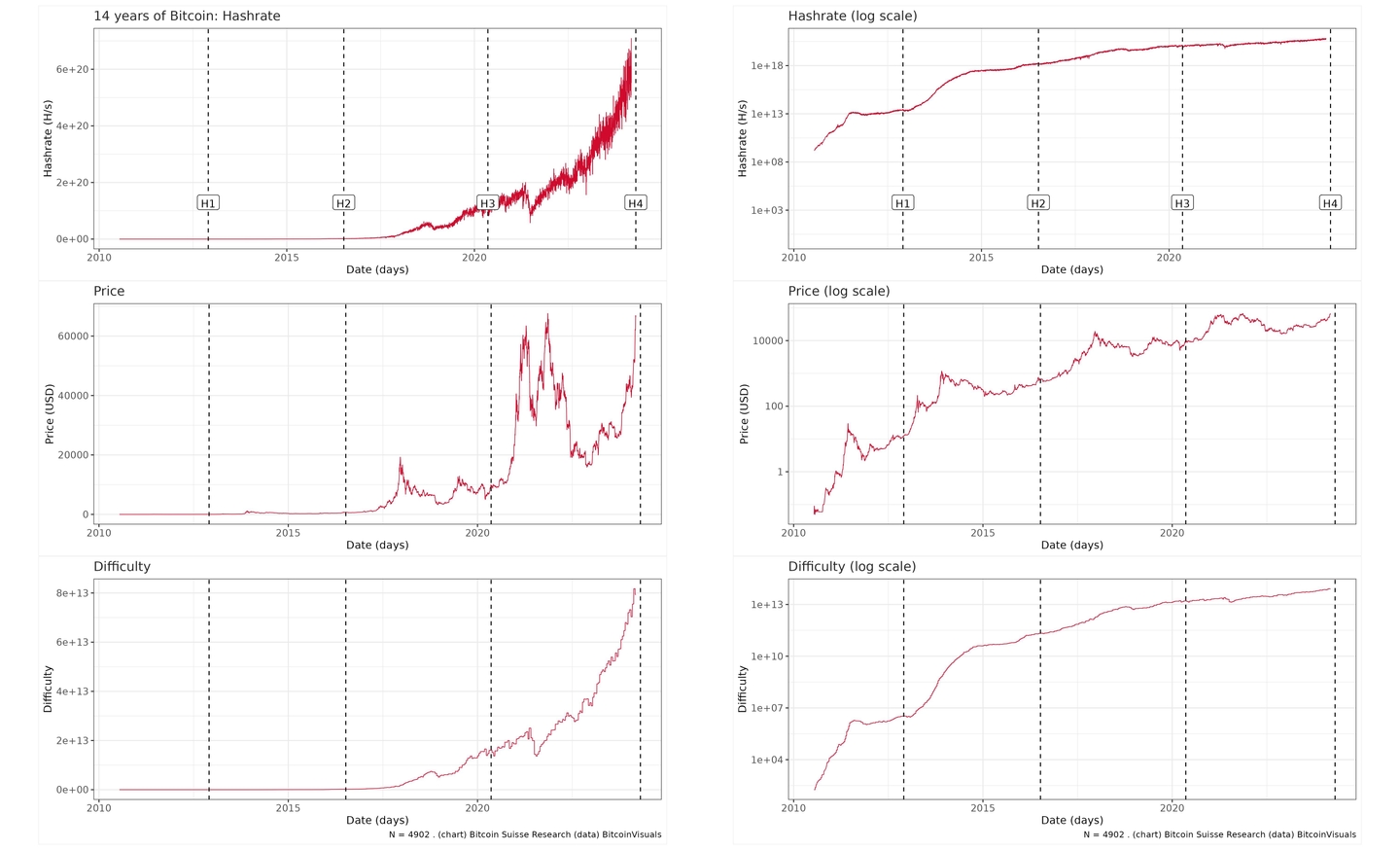
Hashing Out the Halving – The Impact of Halvings on Bitcoin Miners

The block subsidy serves as a fundamental mechanism within the Bitcoin protocol, playing a pivotal role in incentivizing miners to secure the network and validate transactions. It represents the reward granted to miners for successfully mining a new block and adding it to the blockchain (currently at 6.25 BTC per block). The primary purpose of the block subsidy is to provide economic incentives for miners to invest computational power and resources into the network, thereby ensuring its security and integrity. By receiving a reward in the form of newly minted bitcoin, miners are motivated to contribute their hashing power to validate transactions and maintain the decentralized nature of the blockchain.
Hashrate and the difficulty adjustment
Mining difficulty and hashrate are closely intertwined concepts that impact the security and stability of the Bitcoin network. Difficulty refers to the level of computational effort required to mine a new block, while hashrate represents the total computational power contributed by miners to the network. These two factors are inversely related: as the hashrate increases, the mining difficulty adjusts upwards to maintain a consistent block time, ensuring that new blocks are mined at regular intervals, approximately every 10 minutes on average. Conversely, a decrease in hashrate leads to a reduction in difficulty, allowing the network to adapt to changes in mining power and maintain stability.

Bitcoin’s Law of Large Numbers? On the left the development of hashrate, fiat price and difficulty of Bitcoin over the last three halvings are shown. On the right the similarity of the overall dynamics using log scales are highlighted.
The calculation of the difficulty adjustment in Bitcoin is a dynamic process designed to ensure the network's resilience in the face of fluctuations in mining activity. The difficulty adjustment algorithm examines the timestamps of the previous blocks and compares them against the target block time of 10 minutes. If the average time between blocks is shorter than 10 minutes, indicating an increase in hashing power, the difficulty increases to slow down block production. Conversely, if the average time between blocks is longer than 10 minutes, indicating a decrease in hashing power, the difficulty decreases to speed up block production. This adaptive mechanism ensures that the Bitcoin network remains robust and resilient to changes in mining activity. Many consider the idea of adjusting the difficulty dynamically as one of the two foundational innovations by Satoshi Nakamoto; the other one being Proof-of-Work.
What happens at the Halving?
At a halving of the block subsidy, miners are faced with several options to consider in response to the reduction in their mining rewards. One option is to continue mining despite the reduced subsidy, relying on transaction fees to supplement their income. Another option is to scale down operations or even cease mining altogether if the reduced rewards make mining unprofitable. Some miners may choose to upgrade their hardware or optimize their operations to increase efficiency and offset the impact of the halving.
The consequences of these options vary depending on the decisions made by individual miners and the overall dynamics of the mining ecosystem. Continuing to mine despite the reduced subsidy may lead to increased competition for transaction fees and a consolidation of mining power among larger players. Scaling down operations or exiting the market altogether could result in a centralization of mining power as smaller players drop out, potentially affecting the network's security and resilience. Upgrading hardware or optimizing operations may improve efficiency and profitability for some miners, allowing them to remain competitive in the post-halving landscape. A halving usually leads to an overall increase of the hashrate and the efficiency of the remaining mining operations.
Effects on the price of Bitcoin
The halving of the block subsidy also has significant implications for the price of Bitcoin, as it impacts its supply dynamics. Historically, the anticipation and occurrence of halving events have been associated with increased market speculation and price volatility. The reduction in the rate of new bitcoin issuance reduces the available supply of bitcoins entering the market, which can lead to upward pressure on prices, all else being equal. This phenomenon is often attributed to the perception of Bitcoin as a scarce asset with a fixed supply schedule, akin to digital gold. As investors anticipate a reduction in the rate of new supply, they may increase demand for bitcoin in anticipation of potential price appreciation, driving up its value. However, it's important to note that the relationship between halving events and price movements is complex and influenced by various factors, including market sentiment, investor behavior, macroeconomic trends, and external events. While some investors view halvings as bullish catalysts for Bitcoin's price, others may perceive them as priced-in events or temporary phenomena, leading to mixed reactions and outcomes in the market.
The upcoming fourth Halving
The fourth Halving, currently expected to happen on 20 April 2024, is of special interest as several “Firsts” interact in complex ways: (a) for the first time Bitcoin undergoes a halving in a macro environment of high interest rate, inflation and debt levels; (b) the SEC greenlighted 11 Bitcoin spot ETFs in the USA only weeks ago, allowing many TradFi investors to gain exposure to Bitcoin for the first time – leading to (c), Bitcoin beating its previous all-time high mere weeks before the actual halving, another first that leaves everybody wondering what happens next.
Will this lead to an explosive price action at the fourth Halving? Or will ETF demand be exhausted by the halving given the current exorbitant rates? Or will the halving initiate a “super cycle” very different to what came before? Or will the bulls sell in May and go away? In any case, there is no central bank to adjust Bitcoin’s monetary policy to influence what happens in the markets during the next months. So, no prediction from us for this halving, but let me finish with a prediction for the time after the fifth halving – by somebody we all heard of but do not know:
“I’m sure that in 20 years there will either be very large transaction volume or no volume.”
– Satoshi Nakamoto, 14 February 2010